Up and Down Stairs? No Sweat ... Independence & Safety ... Play Structures
Walking on a Balance Board ... Toddler Obstacle Course ... Matching Colors & Designs
A Budding Genius! ... Drawing or Writing? ... Washing Hands ... And Drying Them
Know What Kids Are Capable Of ... Avoid Known Hazards ... Trying to Dress Oneself ... Dressing Games
5 Toddler Hit Songs ... Sing Them Together ... Rhythm & Rhyme ... Finger Play Rhymes
Television and Toddlers ... How Does It Affect Them? ... My Vocabulary Grows ... To 450 Words!
Counting to 5, 10, or 20 ... What Do Numbers Mean? ... The Alphabet ... What Do Letters Mean?
Get Down on the Floor ... Talking with Others ... Fear & Frustration ... Anger & Rage ... Security ... Trust
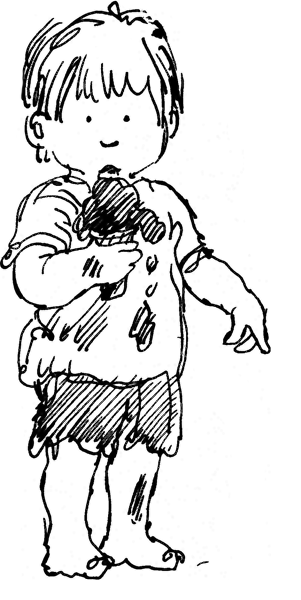 As children pick up information about the world, they process it in two ways: through logical thinking and through fantasy.
As children pick up information about the world, they process it in two ways: through logical thinking and through fantasy.
Logical thinking:
Logical thinking is based on experience. In warm weather an ice cream cone melts. Sometimes it drips to the floor. When you get ice cream on your face, people wipe it off with a napkin. They get annoyed if ice cream drips on the floor. Thus, children slowly manage to learn - by applying logical thinking to experience - how to eat an ice cream cone neatly.
Fantasy:
Children are also able to make up stories and pictures in their minds. If you pick up a little pine cone and say to them, "Pretend this is a tickle monster, who is going to get you - now!" they will go along with you with glee, as long as you don't tickle them too hard. If you put a sock over your hand and say, "Meow," your toddler will pretend with you that your sock is a cat. Logical thinking and pretend thinking are both enjoyable for children.
Children's fears:
Children's ability to fantasize occasionally can get the best of some of them. Not all children suffer fearful fantasies, but some do imagine very scary scenarios, now and in the next few years. The fears of three- and four-year-olds can be worse because they have more knowledge with which to elaborate upon their scary feelings.
At this age, however, toddlers may be afraid of loud noises and unexpected sensations, such as people arriving at your house all of a sudden. They may be afraid of the doctor, of the toilet, of dogs, and of things they saw on television that they can't tell you about because they don't have the necessary language skills.
Without making too big a deal of your child's fears, listen to what you hear and respect your child's feelings. Offer comments, such as "That must have scared you." Cuddle your child when needed, waiting for your child to let go. Restrict television to appropriate shows, provide your child with a doll to "talk" to, and give your child many daily reasons to trust you and feel secure.

Up and Down Stairs? No Sweat
Since children can walk upstairs and downstairs more easily now, you'll find it easier to take them places, such as a museum and the library. You can always use the public access ramps and elevators, of course, but children like to climb big sets of stairs with you. Sometimes going up and down the steps of an art museum is more fun than looking at the paintings inside. But be prepared to go slowly. Trying to hurry with a toddler in tow is pointless.
Independence and Safety
Thirty-month-old children appreciate being able to do things for themselves, so when possible, let them. For example, they may like to have their own umbrella that is just their size. You have to watch constantly, however, for safety factors because children can't anticipate them. They don't know what problems an umbrella can cause. You do, so you explain and watch out.
Play Structures
Toddlers this age crave suitable physical challenges. They love to visit parks that have climbing structures made just for children their age. Such structures usually have low ramps, slides, tunnels, and low platforms to play on.
If you want to buy a jungle gym.
If you are interested in building a jungle gym or helping your community build one, consult local nursery schools and day-care centers. Ask to see their catalogs for child-care equipment. Call the 800 numbers on the catalogs for information. Some companies sell climbing structures that parent volunteers can help put together for a community.
If you want to build one.
Consult woodworking books on children's furniture and play materials. You can find such books in libraries and bookstores. Some designs use tires as part of the structure. All climbing structures for toddlers should be safe, sturdy, stable, toppleproof, made of quality materials, and made with secure grab bars and handrails. |
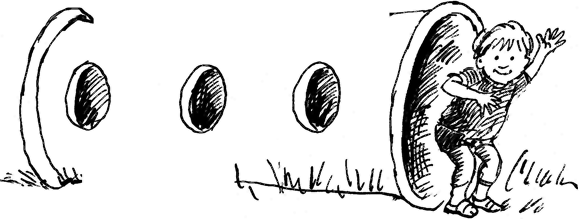
Swings.
Baby swings that strap or hold toddlers in are still used by toddlers. In general, avoid swing sets made for older children. Toddlers are not old enough to comply with safety rules, such as "Don't ever walk in front of the swings." And they can't get up and out of the seats yet.
Sandboxes.
Sand, like water, is a malleable material that children love. You don't have to build a fancy sandbox in the backyard, though you may enjoy doing so. If you're not a carpenter, just fill a toddler pool with sand. You can buy sand at gardening centers and stores that sell gravel and cement mix. |
Walking on a Balance Board
A balance board is a board lifted a few inches off the ground. Stepping up onto a balance board, walking across it, and stepping down provides toddlers with excellent exercise for their leg muscles and an opportunity to improve their sense of balance. To make a balance board put a 9-inch to 12-inch-wide board on two low boards or blocks. Make sure the balance board is safe and sturdy enough for your child to use. Supervise closely to make sure.
Toddler Obstacle Course
Set up an obstacle course for your toddler in an open grassy place. Some obstacles for your child to overcome might be: a tube to crawl through, a balance board, a tire to crawl over, and a small slide to climb up and slide down. If you like, set the objects up in a circle.
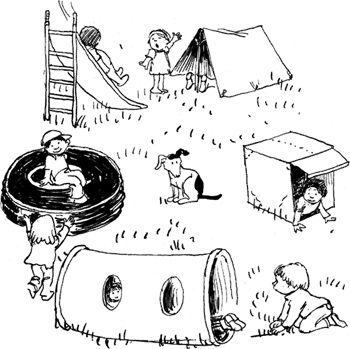
Matching Colors & Designs
Help your child develop observation skills and learn words to describe colors and patterns by pointing out and
discussing various designs found around the home. Your necktie collection may be of great interest to your child.
You can go one step further by encouraging your child to see that certain designs and colors are the same and can be matched. Matching socks is also a good way to approach this activity and get a chore done at the same time.
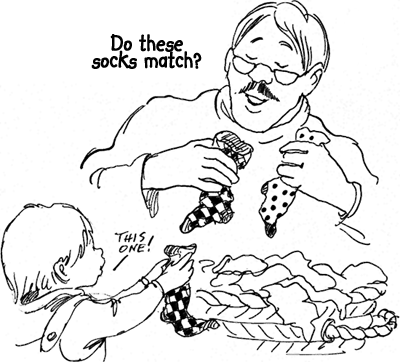
A Budding Genius
How can you tell if your child has a particular talent? Well, at this age, you can't. On the other hand, maybe you can. Look at it this way: Your child exhibits the universal talents of toddlers - a desire to learn and an absolute passion for experience.
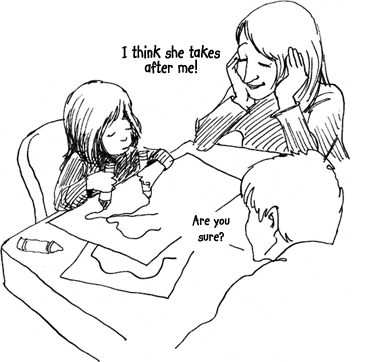 Drawing or Writing?
Drawing or Writing?
Continue to provide crayons and paper to draw with. Actually, there's no reason to assume that your child is always trying to draw a picture. Often, children are trying to write. They don't know what writing is, but they see you doing it; and because they like to copy you, they copy your writing actions. If you're perceptive you may see your child making shapes that look like letters from time to time. You don't need to teach your child to write at this point. That comes later. Most children learn to read and write when they are six. But if your child should ever ask how to draw a certain letter, demonstrate. Your child may or may not be able to copy you, but it's nice that he or she is interested. Some children like to pretend they are writing a book. Note that your toddler probably is able to hold a crayon more comfortably these days.
Washing Hands ...
Along with the improved abilities to make art projects, toddlers have improved abilities to clean up afterward, too.
They can help you wipe off a table with a damp sponge, and by now they can wash and dry their hands with minimal supervision. Inside, you many need to provide a stool for them to climb up to the sink, and you may have to mix the hot and cold water to make warm water. If you're outside gardening, you can give your child a bucket of sudsy water for washing up.
... and Drying Them
Children now are old enough to dry their own hands if you give them a small towel. They can learn to throw a paper towel away when they are done. They can learn to hang up a towel if the rack is low and easy for them to wrap a towel around. Some parents sew snaps or Velcro at the ends of towels so that they do not fall when used by a vigorous toddler.

Know What Kids Are Capable Of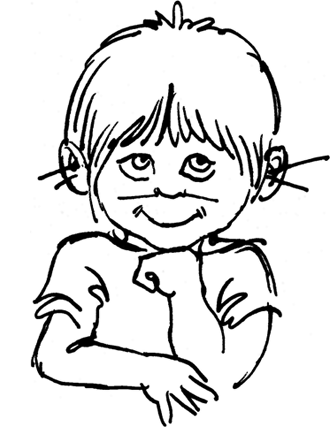
One pediatrician keeps a list posted in her office of all the things she has had to take out of kids' ears: toothpicks, crayons, beans, erasers, peanuts, and would you believe, a piece of salami? Be forewarned.
Watch your kid. How can you protect your child from all the hazards of the world? The answer is you can't. Too many things are out of your control. You just have to have faith that whatever happens you'll be strong enough to deal with it. But there are many hazards that are within your control. You can do something about them.
Avoid Known Hazards
Ask your pediatrician what to do if your child ingests poison. Know the procedure. Go over it with the people who take care of your child. Keep the poison control number posted. Program your phones so that the numbers for the ambulance, and the police and fire departments are easy to call. Post these numbers, too. Think ahead of time about how you would rescue your child and escape if your home were burning. Teach your child to stop at street corners. If your child will not comply, hold your child's hand.
Trying To Dress Oneself
Children this age need still some help with dressing, but they like to do it themselves. So let them - if you have time. On weekends, for example, you can set out some clothes that are easy for your child to put on. Put the clothes on the floor; then sit and have a cup of coffee while your child works away at the task. Offer assistance only when requested. Be proud of your child's sartorial accomplishments.
What to do when there's no time. 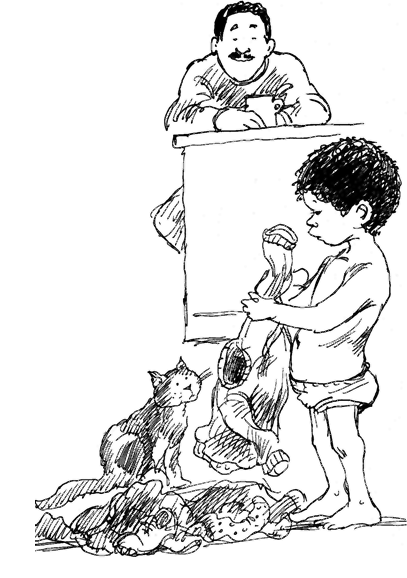
Morning hassles can plague the parents of toddlers. Picture it: You have to get your child up and take him or her to the baby-sitter. You're dressed for work and ready for the day, but your toddler is cranky and uncooperative. What to do? Dress your fussy child. Don't get angry, just get the job done. Your toddler may not be happy, but that's life.
One alternative to difficult mornings: Ask the baby-sitter if you can deliver your child in pajamas. Some baby-sitters who care for children in their homes will allow this. Another alternative is to put your child to bed in the the next day's clothes. Sweatsuits, pajamas - what's the difference?
Dressing Games
Find a red sock.
Have your child look for items of clothing to wear, one by one. The reward for finding something is to put it on.
This is the way we put on our shoes.
To the tune of "Here We Go 'Round the Mulberry Bush," sing about the clothes you help your child put on:
This is the way we put on our shoes,
Put on our shoes,
Put on our shoes,
This is the way we put on our shoes,
On a Monday morning.
One blue shirt and tickle you!
After you put on an article of clothing, tickle your child. As you're dressing your child you say suspensefully, "One blue shirt ... and tickle, tickle you!"
How many clothes can you put on?
This is a silly game for a day when you have nothing better to do.
5 Toddler Hit Songs
Jingle bells, jingle bells,
Jingle all the way;
Oh, what fun it is to ride
In a one-horse open sleigh, hey!
Jingle bells, jingle bells,
Jingle all the way;
Oh, what fun it is to ride
In a one-horse open sleigh, hey!
Sing any time of year. Children like to shake a little bell when they sing it. |
|
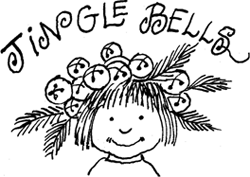 |
| |
|
|
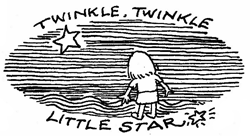 |
|
Twinkle, twinkle, little star,
How I wonder what you are.
Up above the world so high,
Like a diamond in the sky;
Twinkle, twinkle, little star,
How I wonder what you are. |
| |
|
|
I'm a little teapot,
Short and stout;
Here is my handle, (put arm on hip)
Here is
my spout. (bend other arm up)
When I am all ready,
Then I shout,
Tip me over, (bend to the side)
And pour me out. |
|
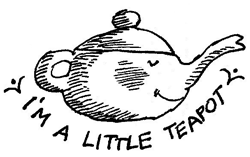 |
Sing Them Together
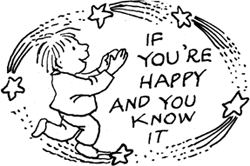 |
|
If you're happy and you know it,
Clap your hands. (clap, clap)
If you're happy and you know it,
Clap your hands. (clap, clap)
If you're happy and you know it,
Then your face will surely show it,
If you're happy and you know it,
Clap your hands. (clap, clap)
Clap as directed. Make up other verses with other actions: shake your head, touch your nose, jump up and down, stamp your feet, and so on. |
| |
|
|
Row, row, row Your boat,
Gently down the stream,
Merrily, merrily, Merrily, merrily,
Life is but a dream.
Imitate rowing motions with your arms, while sitting on the floor, as in a boat. |
|
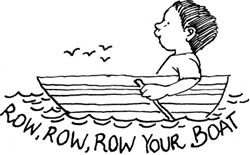 |
Rhythm & Rhyme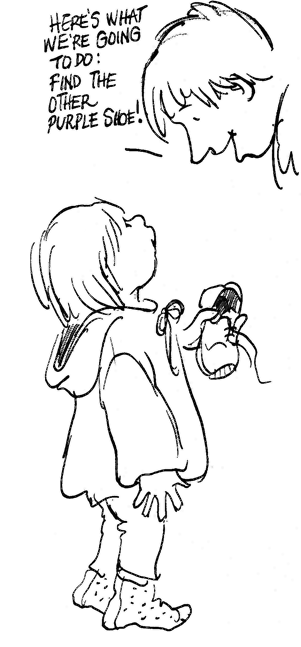
Toddlers respond to rhythm and rhyme. Sometimes you overhear them trying to say jingles from radio and TV commercials. Try to build rhythm and rhyme into your conversations with your child by making up little spontaneous rhymes, such as:
Hey, kid, whaddaya say? How 'bout getting up today?
Here's what we are going to do: Find the other purple shoe.
First the jacket, then the hat, Next the mittens; that is that!
Number rhymes.
Numbers and letters are easy to rhyme with.
Here are some very simple examples:
One, two, Peek-a-boo!
One, two, Tie the shoe!
A, B, C, D,
Can you see me?
One, two, three, four,
Have one bite and then some more!
Finger Play Rhymes
Finger play rhymes are rhymes you act out with your hands and fingers. Children can't say them or do them as well as you can, but that doesn't bother them. They love to try to imitate you, and sooner or later, they can. Here are the words to two fingerplay rhymes, "Itsy Bitsy Spider" and "Two Little Blackbirds."
Ask an older child to teach you and your child how to do them.
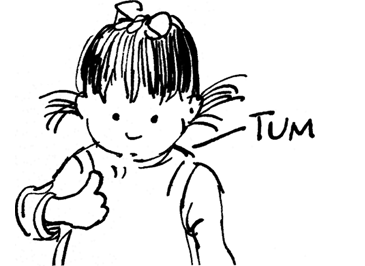 "Itsy Bitsy Spider." *
"Itsy Bitsy Spider." *
Itsy Bitsy Spider went up the water spout,
Down came the rain, and washed the spider out.
Out came the sun, And dried up all the rain,
And Itsy Bitsy Spider went up the spout again.
* Also known as "Eentsy Weentsy Spider."
"Two Little Blackbirds."
Two little blackbirds
Sitting on a hill,
One named Jack,
One named Jill.
Flyaway, Jack,
Flyaway, Jill,
Come back, Jack,
Come back, Jill.
Television and Toddlers
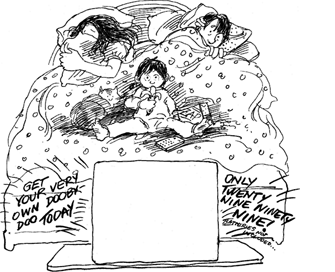 Many toddlers like to watch TV, and for short periods each day, watching TV can be a diversion. After an active afternoon of exploration and free play, for example, a child may enjoy watching a TV show for young children while you fix dinner. Often, tired parents at the end of a work day are relieved to have TV occupy their child while they are busy with household chores. And on weekend mornings you can sometimes get a little more needed sleep if your toddler will watch TV.
Many toddlers like to watch TV, and for short periods each day, watching TV can be a diversion. After an active afternoon of exploration and free play, for example, a child may enjoy watching a TV show for young children while you fix dinner. Often, tired parents at the end of a work day are relieved to have TV occupy their child while they are busy with household chores. And on weekend mornings you can sometimes get a little more needed sleep if your toddler will watch TV.
How Does it Affect Them?
In time, children may turn into TV zombies, otherwise known as couch potatoes, if they watch too much TV. Remember that one of the main ways children learn is by imitation. Children who watch shows that are too old for them and too violent may want to imitate what they see. Another one of the main ways that children learn is through concrete experience. TV is passive. While children are watching TV, they are not playing actively with materials that teach them about the world. Fortunately, many toddlers don't really like TV that much. Left to their own devices, they'll wander away and start playing with toys. When that happens, turn the TV off. Don't have TV noise be a constant in your child's auditory life.
My Vocabulary Grows ...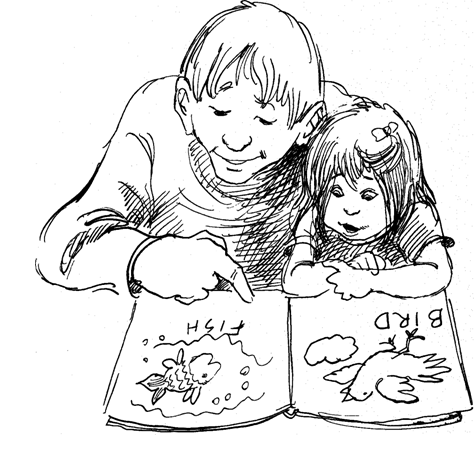
Verbs:
If you say to your child, "What flies in the air?" your child will say, "Bird." If you ask, "What swims in the river?" your child will say, "Fish." Your child doesn't just suddenly comprehend these verbs at the age of 30 months. No, your child learns them because you teach them. The point is that at the age of 30 months your child is able to understand this kind of teaching. Your child has the potential to link certain animals with certain actions but needs your help to actualize the potential. After a while, you can play silly games with this knowledge. What does a fish do? Fly in the sky? Toddlers in the know find this great fun.
... To 450 Words!
Nouns:
Not only does your child know the words to songs and rhymes, but your child is learning many new names for things. Your child may not be able to say them but will understand when you use names for articles of clothing, names for kitchen tools, names for different kinds of food, names for more animals, and the names of more people.
Counting to 5, 10, or 20
Learning to count with you from 1 to 5, from 1 to 10, or even from 1 to 20 is a terrific verbal skill for toddlers to master. Your child doesn't understand the numbers. Counting is like chanting. Your toddler is learning the words to a chant, a perfectly appropriate activity for this age.
You can help your child learn to count by counting aloud together when you do things. When you walk upstairs, you can count them. When you put cans into the recycle bag, you can count them.
When you pick up toys, you can count them, too. Children like to count things on their own. Don't worry if they don't do it correctly.

What Do Numbers Mean?
The concept of one:
Toddlers this age begin to understand the concept of "one." If your child is playing with blocks and you say, "Will you please give me one?" your child may be able to comply, daintily handing over just one.
Other numbers:
But toddlers don't know what other numbers mean. They can memorize numbers to count, and they understand the act of counting things, but the concept of numbers is beyond them for now. If your child counts something, say the peas on his or her plate, you can also count them - correctly, if you like. But don't try to explain why your count is correct; your toddler won't follow your logic - not yet. What you see is what they understand - the act of counting without the more sophisticated and more abstract level of knowledge to come.
The Alphabet
Saying the alphabet, like counting, is equivalent to learning a chant. The letters of the alphabet are like the words to a song. And in fact the "Alphabet Song" is one of the songs young children like to sing best.
Letter recognition is another skill that you may see your toddler develop. Children may look at a gas station sign such as BP and say, "Look, Daddy, a B!" They are recognizing the shape of the letter, perhaps from watching a show such as Sesame Street. They don't yet understand how letters work, however. They are just recognizing them as they would recognize, say, a cow. This is not to diminish their accomplishment; on the contrary, be excited and say, "Yes, that's a B!"
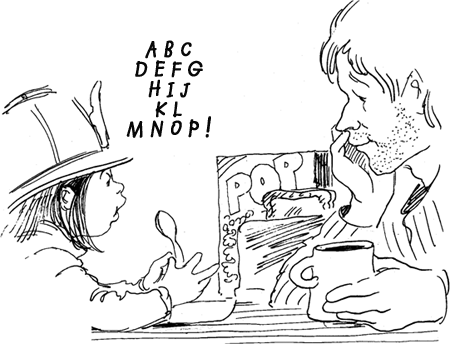
What Do Letters Mean?
That's a good question. What do letters mean? Children look at them on signs and on their cereal boxes. They stare at them as you read a book to them. Slowly, they may begin to sense a connection between the words you say and the letters on the box.
Eventually, with the help of grownups and older children who read to them and teach them, young children figure out the connection between letters and words. They learn to read around the age of six or seven. What toddlers need from you now is a print-rich environment in which they will see lots of letters and books, which you will gladly read to them. In this way the foundation for later reading is built.
Get Down on the Floor
Sometimes the best way to play with your child is to get down on the floor and do what your child is doing. Whatever the activity is, get into it from your child's point of view. Talk about it with your child. The words you use will enliven the experience for your child. Sometimes you can suggest a way to make an activity more exciting without really changing it. For example, if your child says, "I put my guy way up," you can say, "I put my guy way up too." Then you might add, "Where else can we put our guys?" thus expanding the activity to new places· that can be described with more words.
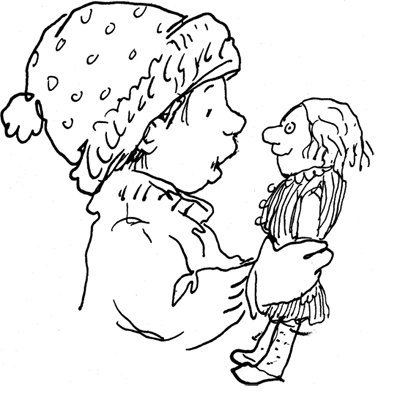 Talking With Others
Talking With Others
You may hear your toddler talking in the other room and wonder who he or she is talking to. The answer may be a doll or teddy bear. Toddlers begin to invent dramatic play in this basic way. Don't interrupt. Just listen. Enjoy the experience as a reward for all the language you have taught your child.
Fear and Frustration
Children have all the feelings you have. They are afraid certain people will hurt them. They know what it feels like to be made fun of. They feel left out when they are the only young child in a group of older children who are ignoring them. They know what it feels like to be the most awkward child in a group or the slowest. They may not know the names for these feelings, but they have them, and you can tell, usually, when they are suffering simply by watching them. Sometimes all you have to do is go over and give them a little attention, a little assistance, and a little TLC.
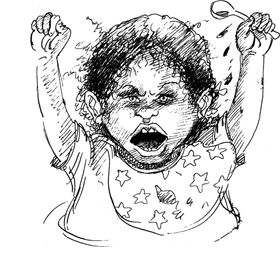
Anger and Rage
Sometimes it helps to understand that just as you get furious at your child, so does your child get furious with you. After all, you control every aspect of your child's life. When you are taking care of your child, you decide what your child will eat, where your child will play, and what will happen next. Your child is programmed to progress inexorably toward independence. The program may take 18 years to run its course, but the urge to experience more independence than you currently allow can send a child into a rage. W AA-A-A!!
Security
You, your wife, and the other people who take care of your child are security to your child. You define the word with the care you provide: shelter, warmth, food, cleanliness, a healthful environment, language, and love. None of these items needs to have a high price tag attached to it. Your toddler doesn't care where he or she lives; all your toddler wants is a family in which people are there for one another.
Trust
Trust is developed in the early years of life. Children learn to trust people when people love them for themselves, are patient with them, and let them make mistakes. Children who learn to trust others develop a positive attitude about the outside world and want to learn more about it.
Grandparents can be wonderful caregivers because they seem to have the knack of providing uncritical love. They are patient, too, with children, having learned the folly of unimportant goals, such as being the best in the class. They value the important goals, such as feeling confident and being willing to take risks. If your child doesn't have grandparents, consider adopting some in your community. Many senior citizens would like to have more contact with young children.
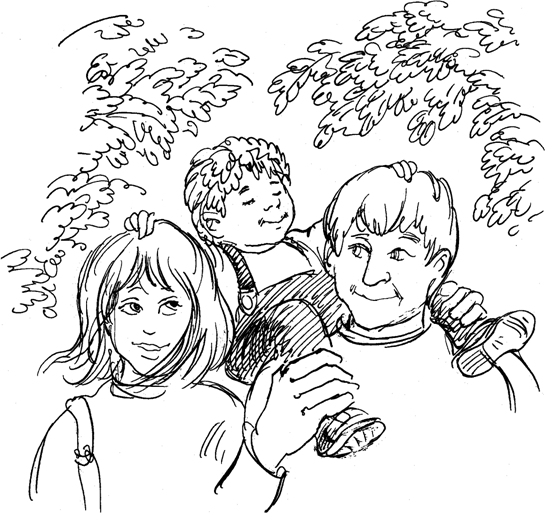
CLICK FOR CHAPTER SIX

